This idea goes back in 1967. James Lovelock, originator of the Gaia hypothesis, found a way to use a planetary atmosphere to detect life. He suggested that we look for simultaneous presence of pairs of gases like oxygen and methane that react together. We can also search for gases such as oxygen above levels expected from abiotic processes.
As far as we can see, Mars atmosphere seems to be close to equilibrium in this way. So when Viking I and II landed there in 1976, and found a barren desert-like surface, it seemed natural to conclude that there is no life on Mars.
However, just the following year, 1977, scientists trawling the ocean depths found life which could not be detected by his methods. Since then we've found many other ways life can get hidden from these observations of the atmosphere:
- Deep underground
- In caves
- Past life that goes extinct
- Life that flourishes every few million years like poppies in a desert
- Sparse populations on the surface right now.
The last of these is the newest, sparking many researches into habitability of present day Mars over the last few years, since Phoenix. Life on a planetary surface could be hidden from these atmospheric measurements simply because of low populations, and a slow metabolism. For details, see "How much oxygen would present day life produce on the Mars surface" below.
(You can get this article as a kindle ebook - 32 printed pages equivalent)
ORIGINAL ARGUMENT
For his original paper see Life detection by atmospheric analysis (1967).
When he wrote this, we had no observations from the Mars surface. The only close up information he had was from the Mariner 4 flyby.
Our best image of Mars when James Lovelock's paper was published - this was taken by Mariner 4 in 1964.
But he didn't need any observations from close up. Its atmospheric composition is something we can measure from Earth, by clever disentangling of doppler shifts - a technique pioneered in the Lick Observatory observatory in 1926,

Lick observatory in 1900. First conclusive proof that there is almost no oxygen on Mars was a paper from this observatory in 1926
ATMOSPHERE OUT OF EQUILIBRIUM WITHOUT LIFE
James Lovelock's argument is not about oxygen alone, because it can be created abiotically.
For instance, on the early Mars, its low gravity makes it easy for the early oceans to evaporate - and then the hydrogen and oxygen dissociate - because it has almost no protection from solar radiation - and then the hydrogen could escape, leaving an oxygen rich atmosphere.
You wouldn't need much, not the 20% levels of Earth, to turn Mars red.
This is the suggestion of Bernard Wood in a paper published in Nature last year.

This shows Gusev crater. He came to his conclusions after studying rocks from Gusev crater, amongst other evidence.
Jupiter's moon Europa has a similar story going on - though for different reasons.
Jupiter's intense radiation splits hydrogen directly from the ice in its icy surface, leaving it oxygen rich. Eventually enough of this may find its way to the under ice ocean keeping it oxygen rich.

JAMES LOVELOCK'S LIFE DETECTION METHOD
His life detection method is based on search for methane and oxygen simultaneously, and other similar trace gases.
"The biological significance of an atmospheric mixture lies in the relative concentrations of a variety of constituents and not wholly in the presence or absence of any single one of them. Such a mixture is biologically significant if it represents a departure from a predictable abiological steady state. The strongest evidence is the simultaneous presence of two gases, like methane and oxygen, capable of undergoing . irreversible reaction; even with gases which can be expected to occur under abiological conditions, departures from the abundances to be anticipated will be of biological significance."
He also suggested that we search for life by looking at isotope ratios.
VIKING RESULTS
Most of the experiments on Viking, didn't detect any life on Mars.
One experiment gave ambiguous results - for more about this, see Rhythms From Martian Sands - What Did Our Viking Landers Find in 1976? Astonishingly, We Don't Know
There is no doubt that his paper was an important contribution to the field - and it went on to become the foundation of his influential and important "Gaia" theory.
However almost immediately, scientists began to find ways that life could evade detection by James Lovelock's method.
FIRST WAY IT CAN BE INVISIBLE - LIFE WITH NO COMMUNICATION WITH THE SURFACE
Hydrothermal vents
First of all, just a few years later, scientists discovered the hydrothermal vent communities around the black and white "smokers" on the sea beds. They form at great depths, where the Earth's plates are pulled apart along the mid ocean ridges.
This was in 1977, just a year after the Viking lander on Mars, and ten years after Lovelock's paper, with the first paper on the subject published in September 1977.
These were able to survive with almost no communication with the surface. The higher lifeforms there did use oxygen dissolved in the water. Some of the microbes however didn't rely on anything except chemical energy and did not need oxygen.
Hydrothermal vent
Tubeworms deep under the ocean living on the hydrothermal vent
Complex flow of chemicals for a hydrothermal vent. See Deep sea vents (Microbe wiki)
The interesting thing here is - that a planet could have communities like this at the depth of oceans - and they would have no effect at all on the atmosphere. Even the chemical byproducts just get dissolved in the ocean and do not return to the atmosphere.
Cold seeps
This is just the first of many such discoveries.
Now we also have cold seeps, where microbes use methane and hydrogen sulfide as an energy source
See Cold Seep Communities
Underground caves
Also underground caves that have almost no communication with the surface. Such as microbes in the Lechugulla cave, isolated from the surface for millions of years.
The caves were carved out by sulfuric acid - which recently was drained exposing the giant crystals.
Life in the rocks themselves
Also life kilometers underground within the rocks themselves.
the "Worm from Hell" from 1.3 kms deep, about half a mm long, lives on microbes, need minimal oxygen.
So - perhaps similarly Mars could have life - but only in caves or deep underground, in some way not connected to the surface.
MARS HYDROSPHERE
It might also have life in its hydrosphere. Unlike Earth, Mars has a cryosphere over its entire surface - a deep layer which remains at temperatures below freezing point of water. But deep down, temperature rises, and a few kilometers below the surface - it gets warm enough - and also pressures high enough - so that there may well be a layer of liquid water. Possibly a hundred meters thick, possibly deeper. This could be an ideal habitat for microbial life - almost completely disconnected from the surface.
Pole to pole cross section of Mars showing the cryosphere - permanently cold enough for ice - and below it, the saline groundwater. This may well be the most habitable region of Mars - on Earth similar habitats deep below the surface have abundant life - but may not be much exchange with the surface.
Mars probably also has hot spots - as it has been geologically active in the recent geological past (though no confirmation yet of any present day hot spots and geological activity). If so - if the hot spot is beneath a "trapping layer" much like an oil field - it could provide another habitat with liquid water and almost no communication with the surface.
SNOWBALL OR SLUSHBALL EARTH
Then a bit later we discovered - that life doesn't need to cover a planet continuously.
Earth has gone through phases in the past when it was covered in ice, or almost completely so. This is the Snowball - or Slushball Earth
Slushball Earth
Perhaps Earth had patches of open ocean in the tropical regions, or perhaps it was completely covered in ice.
Possible Snowball Earth models
For millions of years - the entire surface of Earth -except possibly a small region of pack ice near the equator - was completely covered in ice. Was as barren as Antarctica - but without the penguins of course.
There was life there - but so little - that if you had landed a Viking probe on a random spot on Earth, chances are you would not have spotted a thing.
Once a planet is covered in ice - then it becomes highly reflective, it doesn't absorb as much heat from the sun - so it is pretty hard to get out of it.
Earth got out of this phase because of continental drift, then eventually limestone that deposited in the oceans during its warm phase gets subducted beneath the continents, and then returns to the atmosphere in volcanoes. With no life to turn that back into organics, and no oceans for the CO2 to dissolve into - then the atmosphere got richer and richer in CO2
Finally the ice over the oceans began to melt, and life started to flourish again.
SNOWBALL MARS
This then raises the interesting idea - what if the same thing happened on Mars?
Scientists began to wonder if Mars might have had life in the past - now vanished. Or perhaps life there - but only occasionally depending on the tilt of its axis. Mars is dry right now, but might have shallow ponds occasionally as the atmosphere gets thicker.
At other times, it might survive as dormant spores, perhaps buried deep below the surface in caves or underground, protected from cosmic radiation.
We now have pretty conclusive evidence that Mars had a shallow ocean covering much of its northern hemisphere in the first few hundred million years of the solar system (and briefly again a billion years later).
At the very beginning, it's thought that Mars, Earth and Venus were almost identical with dense CO2 rich atmospheres of tens of atmospheres of pressure - which raised the boiling point of water permitting all three planets to have global oceans of water well above boiling point - planetary pressure cookers.
These atmospheres were also nitrogen rich - and the seas were rich in nitrates formed during asteroid impacts in the "Late heavy bombardment" - and probably also organics delivered by comets.
Mars is further out from the sun of course, and had no Moon impact. So life may have begun there earlier than on Earth. It cooled down more quickly however - and entered the snowball phase far sooner than Earth.
And - Mars has no continental drift. So unlike Earth which went through many snowball phases and survived - Mars just got colder and colder. There were temporary respites - floods perhaps due to giant impacts - also its axial tilt and orbit changes far more than the Earth's so that also led it's oceans to melt from time to time.
But before long it went into a permanent snowball phase. And then eventually - the ice disappeared as well - either lost to space - or underground - we don't know. At any rate it is currently as cold or colder than Snowball Earth ever was - but without any ice so dry as well.
WHAT WOULD HAPPEN TO LIFE ON PRESENT DAY MARS
So - let's suppose for purposes of discussion that Mars did have life in the early solar system? What would happen to it as a result of this snowball phase?
Well - to start with for sure, would be like Earth. There is life there - but it's hard to detect and mainly underground.
What little there was left on the surface - would have no detectable effect at all on the atmosphere.
If we were to spot an exoplanet like that around another star - then again - we would have no way of knowing that there is life there. And if you landed Curiosity on it - you would not expect to find anything.
Eventually - you might think - with the surface completely frozen, and no liquid water - it would be totally underground - so - this seems, on the face of it - to feed into the idea that Mars must be totally lifeless on the surface - and only have life deep underground.
However, various discoveries in Antarctica and in the permafrost layer have changed this picture
MARS CAN'T GET OUT OF ITS CURRENT "DRY SNOWBALL" PHASE THROUGH BIOLOGY.
There is no way that life on Mars could turn it back into a planet like Earth. It's too cold, too far from the sun, too dry etc.
Earth was only able to escape its snowball phase because of continental drift, which Mars doesn't have
But - it could have continued to survive, by "going slow" as the planet became less and less habitable.
MICROBES THAT ARE ALMOST DORMANT - BUT NOT QUITE
Some deep sea microbes have such a slow metabolic rate that they take 1000 years to divide, They have a metabolic rate of a millionth, or a ten millionth of a grams of carbon per hour for every gram of carbon in the cell (typical rates are between a tenth and a thousandth of a gram of carbon per hour).
This obviously would have minimal effect on the atmosphere.
And some metabolize even more slowly.
Mars polar regions - one of the places where slowly metabolizing microbes may be able to survive, similar to P. cryohalolentis, an ordinary microbe but able to repair 10 DNA base pairs a year.
P. cryohalolentis can't survive 600,000 year's worth of damage on the Earth, but was found still alive in 600,000 year old deposits in permafrost and Antarctic sea ice. The researchers believe it did this by metabolizing extremely slowly throughout the time period, using its ability to slowly repair DNA damage at about 10 base pairs of DNA a year.
This makes it a good candidate for a Mars microbe. The researchers said that it might also have reproduced occasionally - they couldn't tell - but it might have survived simply by using a slow metabolism + DNA repair. See Even Ordinary Microbes May Survive Radiation on Mars
LIFE THAT CAN SURVIVE IN TINY MICROHABITATS
Then we have had discoveries of possible habitats for life. I've covered this a fair bit in my other articles, and - one of the most promising are the warm seasonal flows, more of this in a minute.
But, let's just to mention the most recent discovery, by Nilton Renno's team.
They experimented in Mars simulation chambers found that they got tiny drops of water on the interface between salt and ice, in Mars like conditions. These could be widespread over the surface of Mars - but only as tiny droplets perhaps a few mm across, that form for a few hours a day, a few days a year.
""Based on the results of our experiment, we expect this soft ice that can liquify perhaps a few days per year, perhaps a few hours a day, almost anywhere on Mars. So going from mid latitudes all the way to the polar regions. This is a small amount of liquid water. But for a bacteria, that would be a huge swimming pool - a little droplet of water is a huge amount of water for a bacteria. So, a small amount of water is enough for you to be able to create conditions for Mars to be habitable today'. And we believe this is possible in the shallow subsurface, and even the surface of the Mars polar region for a few hours per day during the spring." (transcript from 2 minutes into the video onwards)"
That's Nilton Renno, who lead the team of researchers. See also Martian salts must touch ice to make liquid water, study shows
So, what effect would something like this have on the Mars atmosphere?
I'm not going to try any detailed analysis. But let's look at something quite crude, the amount of oxygen the lifeforms produce.
I know that oxygen is not a sign of life by itself. But the amount of oxygen produced by photosynthetic lifeforms can give a rough idea of how much impact they can have on the atmosphere.
HOW MUCH OXYGEN WOULD SURFACE LIFE PRODUCE ON MARS?
We can get some idea of this from measurements of microbal mats in ice covered lakes in the dry McMurdo valleys.
These measurements were taken in Lake Hoare
Lake Hoare (Antarctic explorers)
Benthic Microbial Mats Ice-Covered Antarctic Lakes
See Photosynthetic performance of benthic microbial mats in Lake Hoare, Antarctica
The researchers estimated oxygen production of the microbial mats at around 0.089 micrograms per square centimeter of surface per hour. That's 0.0089 grams per square kilometer per hour, or about 89 grams per square kilometer per year of oxygen production.
For the next step we need to know the "residence time" - how long the oxygen remains in the atmosphere. I can't find figures for Mars - anyone know (for methane it is 430 years)?
However, on Earth, atmospheric oxygen has a residence time of 4500 years. So, if oxygen lasts as long in the Mars atmosphere as it does on Earth, that takes the total amount of oxygen in the atmosphere up to 4500 * 0.089 or around 0.4 tons per square kilometer
That is, of course, if the entire surface was as habitable as ice covered lakes in Antarctica.
How does that compare with the mass of the Mars atmosphere?
Using the average atmospheric pressure of 7 millibars, gravity 38% of Earth's, so 10 tons per square meter requires 26 tons per square meter on Mars, so 7 millibars requires about 0.182 tons per square meter, or about 182,000 tons per square kilometer.
So our 0.4 tons per square kilometer would contribute about 0.0002% by weight of oxygen to the Mars atmosphere.
As it turns out, Mars does have oxygen already, at far higher levels than that.
Curiosity measured 0.145% of oxygen in the Mars atmosphere (mole fraction).
We don't really need to convert that to percentage by weight - is clear that Curiosity could not spot oxygen at 0.0002%. And diurnal cycles are going to be less than 0.4 parts per billion, at the limits of its sensitivity and surely hidden in the noise.
That is for the entire surface of Mars as productive as the Antarctic ice covered lakes - and all that oxygen ends up in the atmosphere.
HOW MUCH OXYGEN WOULD LIFE PRODUCE IN RARE HABITATS LIKE THE WARM SEASONAL FLOWS?
It's hardly likely that the surface has on average as much photosynthetic life as an ice covered lake in Antarctica.
Suppose that it only occurs in the warm seasonal flows?
These are exceedingly rare. Each asterisk on this map shows one of the sites
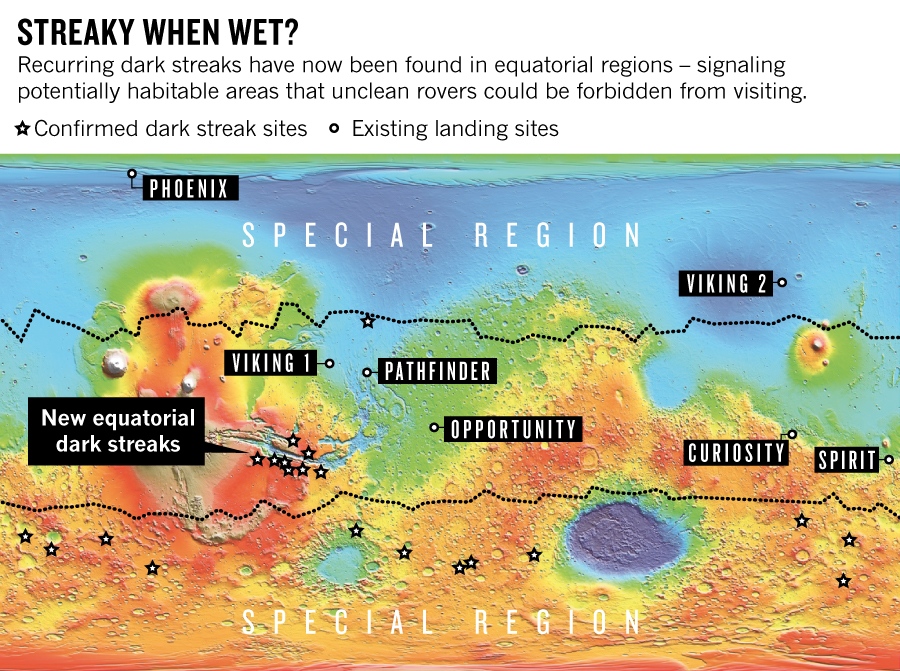
Sixteen sites in total marked, over entire surface of Mars. See Water seems to flow freely on Mars
So there aren't many of them. And the habitats themselves consist of just thin streaks on the slopes like this

Suppose, for example, that we had a total of ten square kilometers surface area of these dark streaks on Mars - I mean just the streaks themselves. I expect that's an over estimate - but - this is just to give a very rough idea of what's involved here.
Suppose that they really are liquid water, as they seem to be - and suppose they are all inhabited by biofilm of life to a depth of a few mms as in Antarctica. And suppose these are all photosynthetic lifeforms.
Then that would be less than 1 kg of oxygen production over entire Mars surface, per year, and assuming a residence time of 4500 years, then a total of 4 tons of oxygen in the atmosphere.
At these levels, we have almost no chance of spotting Lovelock's traces of reactive gases.
Many other habitats suggested on Mars are also rare, such as the Martian Geysers. And others may be common - but consist of tiny droplets, like the ones found by Niton Tenno's team.
PROBLEM OF NITRATES
One major problem for life on Mars is the lack of nitrogen in the Mars atmosphere. Nitrogen is essential to life as we know it. However - Mars does have a bit of nitrogen in its atmosphere. And meteorite impacts continually deliver nitrates to Mars. Lightning can create nitrates also.
Another source of nitrogen - it might have deposits of nitrates from the early Mars. These might be deep underground, as happened in the Atacama desert, so not so obvious for our rovers to find.
This was just a hypothesis until last year -when Curiosity discovered the first conclusive evidence of nitrates on Mars.
So - it does have nitrates - patchy surely, low levels - but are present. And remember Curiosity can't drill even cms below the surface.
The McMurdo dry valleys and the Atacama deserts are similarly challenging in this way also - not much at all by way of nitrates - unless a micro-organism is nitrogen fixing.
There is a small amount of nitrogen in the Mars atmosphere, 0.2 millibars. One study found that microbes could continue to do nitrogen fixation at 5 millibars, but they found no evidence of fixation below 1 mbar. This was done at Earth normal atmospheric pressure. This is a 1989 paper: Biological nitrogen fixation under primordial Martian partial pressures of dinitrogen.
Can any extremophiles handle nitrogen fixation in the Mars atmospheric conditions? I've asked around but nobody seems to have studied this.
An obvious follow up experiment would be to do the same tests, but with Antarctic nitrogen fixating extremophile micro-organisms. The authors of this paper propose the experiment to do that, but as far as I can see, haven't actually done it
However one way or another seems at least possible that surface life on Mars may have access to enough nitrogen, at least in places, at levels similar to nitrogen poor dry deserts on Earth..
WHAT ABOUT IONIZING RADIATION
Curiosity measured solar and cosmic radiation levels on the surface of Mars at roughly the same as the levels in the interior of the ISS. It is not particularly hostile for radioresistant microbes that wake up for a few hours a year. The most radioresistant Mars analogue organism, Chroococcidiopsis can repair tens of thousands of years worth of damage to its DNA in a few hours.
The Mars surface radiation is only hostile to dormant life. Over a billion years, then even the most radioresistant lifeform is reduced to almost nothing (1 in a trillion reduction in amino acids).
For more about this, see Cosmic Radiation, UV And Perchlorates On Mars - Not Lethal For Possible "Swimming Pools For Bacteria" - On Ice / Salt Interfaces
It does however mean that life needs to be there continuously. If there ever was a gap of time when the Mars surface became totally uninhabitable for a few million years, no life would survive on the surface, as far as we know, at least.
Of course that's the big question. If the habitats do exist, and there was life in them in the past - was it also able to survive continuously right up to the present day? Or were they reseeded by life from some other source at some point (underground, or from Earth say)? Or are they currently uninhabited?
ISOTOPE MEASUREMENTS OF LIQUID WATER ON MARS
Observations by the Phoenix lander show that present day Mars has liquid water on the surface - either all the time - or episodically in recent geological past. We know that because of isotope evidence of chemical exchange of oxygen atoms with the CO2 in the atmosphere.
That's far from actually proving that there is present day life there - or that there are habitats there - but it leaves the possibility open at least
DOES MARS HAVE PRESENT DAY, OR PAST LIFE?
Perhaps Phoenix detected evidence of the Warm Seasonal Flows - and Nilton Renno's "swimming pools for bacteria. Or perhaps it detected evidence of occasional impacts or volcanic hot spots that liberate floods of water onto the surface?
If these habitats do exist - is there any life in them? Or - has life on Mars gone extinct?
Or does it still exist but only underground, or on the surface, but only occasionally?
Nobody knows at present.
When searching for sparse communities contributing at most a few tons of oxygen to the atmosphere, in total, over the entire surface of Mars then we may have to go right up close to the microbes to spot anything. Even then, they might be hard to spot.
Then another complication, with such sparse habitats and slowly metabolizing life - how long does it take life to "discover" a new habitat on Mars? On Earth it happens within weeks and months, habitats created in volcanic eruptions are colonized almost immediately.
On Mars, this process could easily take centuries, millennia, or even longer. So it's quite possible that some of the habitats are inhabited, and other, equally good habitats, have no life in them.
COMMENTS
Please use the comments section below. Intersted to hear any thoughts, reactions etc. If you have other views don't hesitate to say. Also if you spot anything here that needs to be corrected again, don't hesitate.
Sometimes comments get delayed because of the spam filter - I need to click on them as "ham" to approve them. Occasionally the comments may get deleted before I notice they are there. If this happens, my apologies, and please try again!
HOW TO GET THIS ARTICLE AS A KINDLE EBOOK
You can get it here:


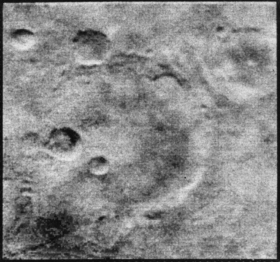
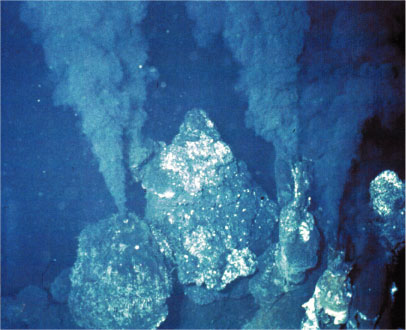
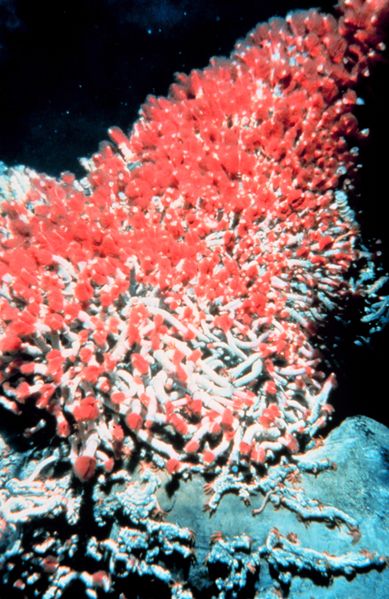
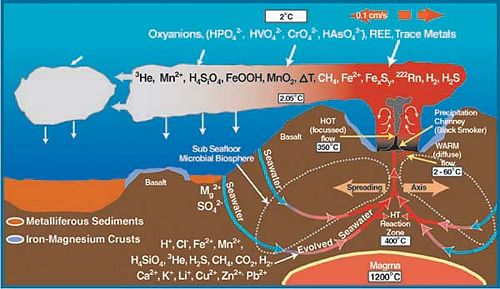





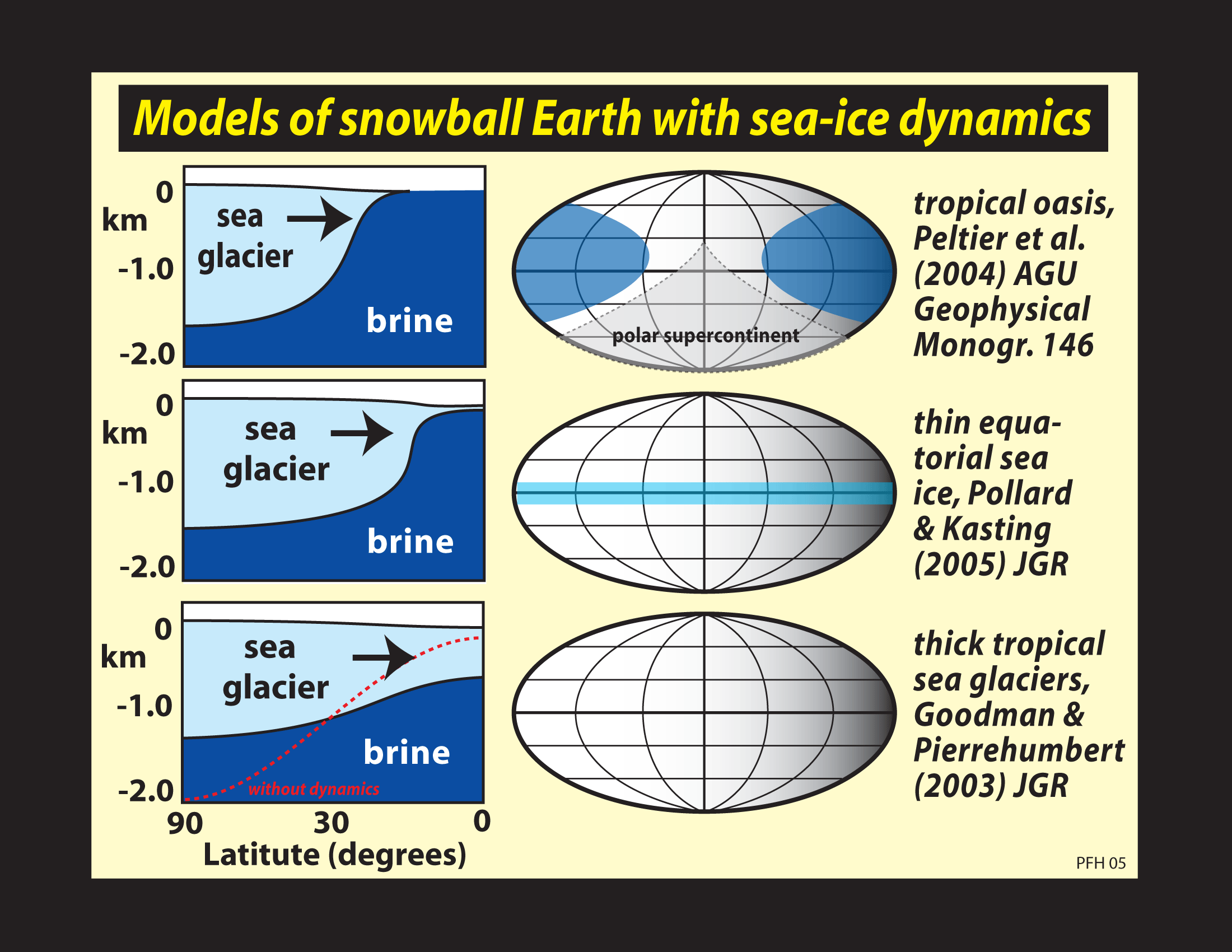






Comments